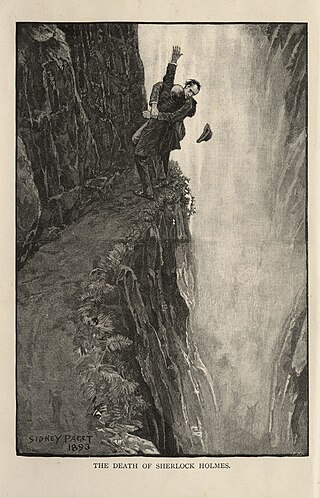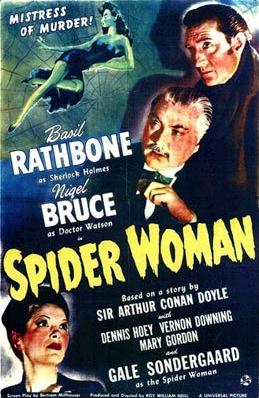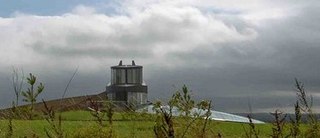
Mycroft Holmes is a fictional character appearing in stories written by Sir Arthur Conan Doyle from 1893 to 1908. The elder brother of detective Sherlock Holmes, he is a government official and a founding member of the Diogenes Club. Mycroft is described as having abilities of deduction and knowledge exceeding even those of his brother, though their practical use is limited by his dislike of fieldwork.

"The Final Problem" is a short story by Sir Arthur Conan Doyle featuring his detective character Sherlock Holmes. It was first published in The Strand Magazine in the United Kingdom, and McClure's in the United States, under the title "The Adventure of the Final Problem" in December 1893. It appears in book form as part of the collection The Memoirs of Sherlock Holmes.

"The Adventure of the Empty House", one of the 56 Sherlock Holmes short stories written by Sir Arthur Conan Doyle, is one of 13 stories in the cycle collected as The Return of Sherlock Holmes. It was first published in Collier's in the United States on 26 September 1903, and in The Strand Magazine in the United Kingdom in October 1903.

Colonel Sebastian Moran is a fictional character in the stories written by Arthur Conan Doyle. An enemy of Sherlock Holmes, he first appears in the 1903 short story "The Adventure of the Empty House". Holmes once described him as "the second most dangerous man in London", the most dangerous being Professor Moriarty, Moran's employer.
Sherlock Holmes has long been a popular character for pastiche, Holmes-related work by authors and creators other than Arthur Conan Doyle. Their works can be grouped into four broad categories:
Many writers make references to Sir Arthur Conan Doyle's famous literary creation, the detective Sherlock Holmes, and these often become embedded within popular culture. While Holmes exists predominantly in the context of Victorian-era London, he has been mentioned in such outre contexts as the 22nd century or hunting aliens or supernatural enemies. These references are in addition to the innumerable passing references to Sherlock Holmes made in many literary and cinematic works, such as the labeling of a person as a "Sherlock", whether in reference to their intelligence.

The Spider Woman is a 1943 mystery film starring Basil Rathbone as Sherlock Holmes and Nigel Bruce as Dr. Watson, the seventh of fourteen such films the pair were involved in. As with all of the Universal Studios films in the series, the film is set in then-present day as opposed to the Victorian setting of the original stories. This film incorporates elements from the 1890 novel The Sign of the Four, as well as the short stories "The Final Problem", "The Adventure of the Empty House", "The Adventure of the Speckled Band" and makes explicit reference to "The Adventure of the Devil's Foot".

Sherlock is a British mystery crime drama television series based on Sir Arthur Conan Doyle's Sherlock Holmes detective stories. Created by Steven Moffat and Mark Gatiss, it stars Benedict Cumberbatch as Sherlock Holmes and Martin Freeman as Doctor John Watson. Thirteen episodes have been produced, with four three-part series airing from 2010 to 2017 and a special episode that aired on 1 January 2016. The series is set in the present day, while the one-off special features a Victorian period fantasy resembling the original Holmes stories. Sherlock is produced by the British network BBC, along with Hartswood Films, with Moffat, Gatiss, Sue Vertue and Rebecca Eaton serving as executive producers. The series is supported by the American station WGBH-TV Boston for its Masterpiece anthology series on PBS, where it also airs in the United States. The series is primarily filmed in Cardiff, Wales, with North Gower Street in London used for exterior shots of Holmes and Watson's 221B Baker Street residence.

The Adventures of Sherlock Holmes and Dr. Watson is a 1980 Soviet film adaptation of Arthur Conan Doyle's stories about Sherlock Holmes. It is the second film in The Adventures of Sherlock Holmes and Dr. Watson film series directed by Igor Maslennikov.
This article describes minor characters from the Sherlock Holmes stories by Sir Arthur Conan Doyle, and from non-canonical derived works. The list excludes the titular character as well as Dr. Watson, Professor Moriarty, Inspector Lestrade, Mycroft Holmes, Mrs. Hudson, Irene Adler, Colonel Moran, the Baker Street Irregulars, and characters not significant enough to mention.
"The Great Game" is the third and final episode of the first series of the television series Sherlock. It was first broadcast on BBC One and BBC HD on 8 August 2010. It was written by Mark Gatiss and directed by Paul McGuigan.
"A Scandal in Belgravia" is the first episode of the second series of the BBC crime drama series Sherlock, which follows the modern-day adventures of Sherlock Holmes, and was first broadcast by BBC One on 1 January 2012. It was written by co-creator Steven Moffat, and directed by Paul McGuigan. The episode was based on "A Scandal in Bohemia", a short story by Sir Arthur Conan Doyle.

"The Hounds of Baskerville" is the second episode of the second series of the BBC crime drama series Sherlock, which follows the modern-day adventures of Sherlock Holmes, and was first broadcast by BBC One on 8 January 2012. It was written by co-creator Mark Gatiss, who also portrays Mycroft Holmes, Sherlock's brother in the series, and was directed by Paul McGuigan. The episode is a contemporary adaptation of The Hound of the Baskervilles, one of Sir Arthur Conan Doyle's most famous works.

"The Reichenbach Fall" is the third and final episode of the second series of the BBC television series Sherlock. It was written by Stephen Thompson and stars Benedict Cumberbatch as Sherlock Holmes, Martin Freeman as Dr John Watson, and Andrew Scott as Jim Moriarty. The episode deals with Moriarty's attempt to undermine the public's view of Sherlock and drive him to suicide. The episode was first broadcast on BBC One and BBC One HD on 15 January 2012. It attracted 9.78 million viewers, and critical reaction to the episode was positive. After the episode was aired, there was also much online and media speculation, which focused on Sherlock's death.
"The Sign of Three" is the second episode of the third series of the BBC television series Sherlock. It was written by Stephen Thompson, Mark Gatiss and Steven Moffat, and stars Benedict Cumberbatch as Sherlock Holmes and Martin Freeman as Dr John Watson. The episode's title is inspired by The Sign of the Four by Sir Arthur Conan Doyle. It is set six months after the series opener "The Empty Hearse" and is primarily centred on the day of Watson's wedding to Mary Morstan. It garnered a viewership of 11.37 million, and received mostly positive reviews.

"His Last Vow" is the third episode of the third series of the BBC Television series Sherlock, which follows the modern-day adventures of Sherlock Holmes. The episode was first broadcast on 12 January 2014, on BBC One and Channel One. It was written by Steven Moffat and directed by Nick Hurran with music composed by Michael Price and David Arnold. The episode is a contemporary adaptation of Sir Arthur Conan Doyle's short story "The Adventure of Charles Augustus Milverton".
"The Abominable Bride" is a special episode of the British television programme Sherlock. The episode was broadcast on BBC One, PBS and Channel One on 1 January 2016. It depicts the characters of the show in an alternative timeline: the Victorian London setting of the original stories by Arthur Conan Doyle. The title is based on the quote "Ricoletti of the club foot and his abominable wife" from "The Adventure of the Musgrave Ritual" (1893), which refers to a case mentioned by Holmes. The story also draws on elements of original Conan Doyle stories of Holmes such as "The Five Orange Pips" (1891) and "The Final Problem" (1893).
"The Six Thatchers" is the first episode of the fourth series of the British television programme Sherlock and the eleventh episode overall. The episode was first broadcast on BBC One, BBC First, PBS and Channel One on 1 January 2017.









